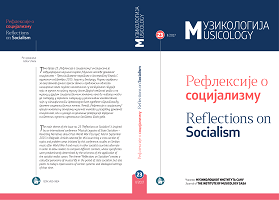Уобличавање Националног Памћења: Почеци Меморисања Стевана Стојановића Мокрањца У Српској Музици (1919–1923)
Shaping National Memory: The Beginning Of Memorizing Stevan Stojanović Mokranjac in Serbian Music (1919–1923)
Author(s): Biljana MilanovićSubject(s): Cultural history, Customs / Folklore, Music, Cultural Anthropology / Ethnology, Pre-WW I & WW I (1900 -1919), Interwar Period (1920 - 1939), Sociology of Art, History of Art
Published by: Muzikološki institut SANU
Keywords: national musical canon; Stevan Stojanović Mokranjac; national memory; choral music; concerts;
Summary/Abstract: The organization of musical life of Belgrade as the capital of the newly founded Kingdom of Serbs, Croats and Slovenes was characterized by eforts towards a material, economic and cultural consolidation of the city afer a war disaster; thus the mapping of continuity with pre-war traditions acquired a special signifcance. Te frst joint performance of Belgrade choirs in peacetime conditions, organised by the Belgrade Choral Society (1919) and dedicated exclusively to Mokranjac’s output testifed to that efect. Soon there followed four similar events (1922– 1923), and then a manifestation of the transfer of Mokranjac’s remains from Skopje to Belgrade (1923). Te aim of this article is to examine these events as the frst, though belated (due to war circumstances) cases of memorizing Mokranjac afer his death in 1914. Tis research has taken into account the processes of canonization of Mokranjac that had begun even during his lifetime, and the critical examination of the canon is complemented by theoretical elements from memory studies, because these events are about a (re)interpretation of the canon of national art music through strategies of memorialization. Concerts and narratives that are directly related to them are marked as artistic memorials to Mokranjac; aferwards, I analyzed the commemoration ceremony itself. Considering the results of the analysis, I concluded that these were two types of memorizing Mokranjac, one of which was in the domain of the professional music elite, while the other one acquired the proportions of the national-state event. Accordingly, they also ofered two kinds of national memory. On the one hand, the version presented by the representatives of the elite contributed to the canonization of Mokranjac and the creation of national memory within the dominant group in the field of music which, through its narrative about Mokranjac, expressed its own aesthetic orientation and reinforced its social positions. On the other hand, the mass gathering of various representatives of the state, civil institutions and citizens pointed to the apposite narratives of glorifying Mokranjac, while loading the ideology of the ofcial state apparatus and puting memories of Mokranjac into desirable Yugoslav frameworks.
Journal: Muzikologija
- Issue Year: 2/2017
- Issue No: 23
- Page Range: 199-218
- Page Count: 20
- Language: Serbian

